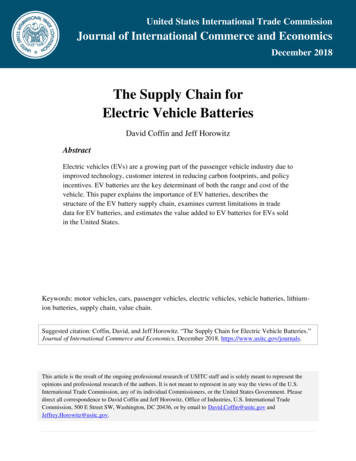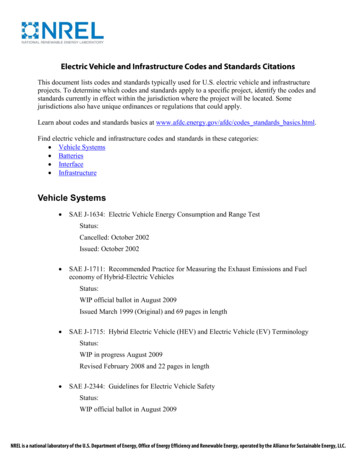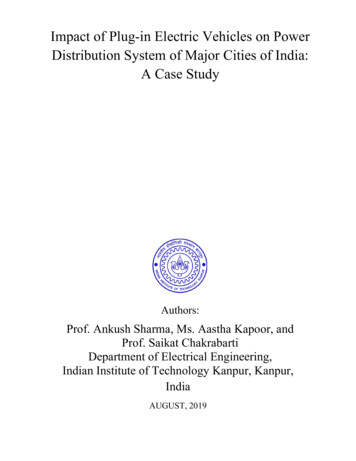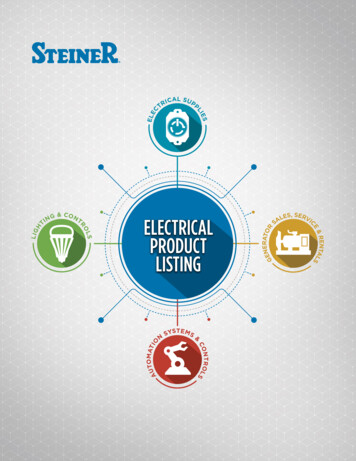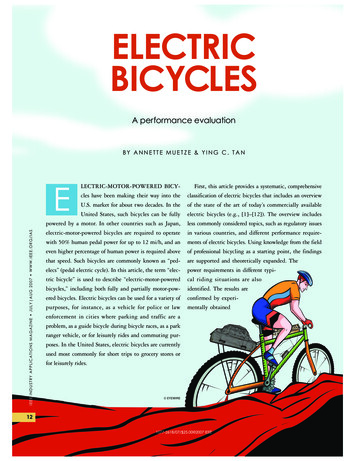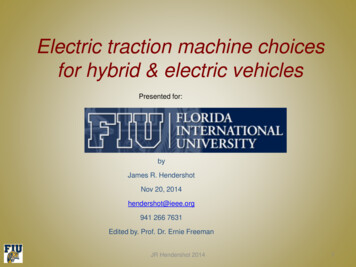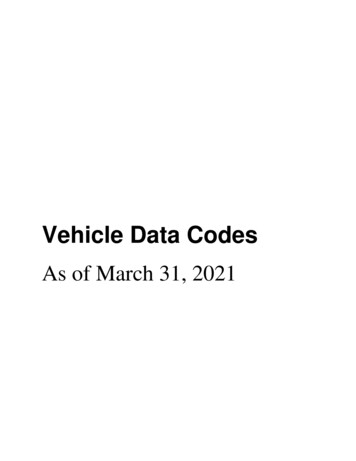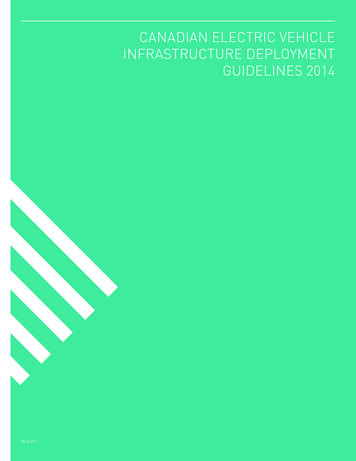
Transcription
CANADIAN ELECTRIC VEHICLEINFRASTRUCTURE DEPLOYMENTGUIDELINES 2014DC14-071
REPORT FORCEATI INTERNATIONAL Inc.1010 Sherbrooke Street West, Suite 2500Montreal, QuebecCanada H3A 2R7Website: www.ceati.comSTRATEGIC OPTIONS FOR SUSTAINABLE POWER GENERATION INTEREST GROUP (SOIG)CEATI REPORT No. T112700-0536CANADIAN ELECTRIC VEHICLE INFRASTRUCTURE DEPLOYMENT GUIDELINESPrepared byECOtality North AmericaSan Francisco, California, USAPrincipal InvestigatorStephen ScheySponsored byBC HydroHydro OneManitoba HydroNatural Resources CanadaTechnical AdvisorHal LaFlash, BSME, MBAMarch 2014iiCanadian EV Infrasturcture Deployment Guidelines 2014
NOTICEThis report was prepared by the ECOtality North America and administered by CEATI International Inc. (CEATI) for the ultimate benefitof CONSORTIUM MEMBERS (hereinafter called “SPONSORS”). Neither of the latter parties necessarily agrees with the opinionsexpressed herein.Neither the SPONSORS, nor CEATI, nor the ECOtality North America, nor any other person acting on their behalf (a) makes anywarranty, express or implied, or assumes any legal responsibility for the accuracy of any information contained in this report or forthe completeness or usefulness of any apparatus, product or process disclosed in the report, (b) accepts any liability for the use of, ordamages resulting from the use of this report or any apparatus, product or process disclosed in this report or (c) represents that the useof such apparatus, product or process would not infringe upon the rights of third parties.Furthermore, the SPONSORS, CEATI and the ECOtality North America HEREBY DISCLAIM ANY AND ALL WARRANTIES, EXPRESSEDOR IMPLIED, INCLUDING THE WARRANTIES OF MERCHANTABILITY AND FITNESS FOR A PARTICULAR PURPOSE, WHETHER ARISINGBY LAW, CUSTOM, OR CONDUCT, WITH RESPECT TO ANY OF THE INFORMATION CONTAINED IN THIS REPORT. In no event shall theSPONSORS, CEATI or the ECOtality North America be liable for incidental or consequential damages because of use or any informationcontained in this report.Any reference in this report to any specific commercial product, process or service by tradename, trademark, manufacturer or otherwisedoes not necessarily constitute or imply its endorsement or recommendation by the ECOtality North America, the SPONSORS or CEATI.Copyright 2014 CEATI International Inc. All rights reserved.iiiCanadian EV Infrasturcture Deployment Guidelines 2014
ABSTRACTThis report provides the essential information and resources required to implement electric vehicle (EV) charge infrastructure. Thereport touches various topics e.g. different power requirements for AC Level 1 and Level 2 chargers, DC Level 2 chargers, ElectricVehicle Technology, Canadian legislative codes and standards, and site planning of residential, commercial and public charging. CEATIInternational’s goal for this project was to prepare an infrastructure installation guideline, an online resource for the proper deployment ofelectric vehicle charge infrastructure to further advance the electrification of transportation.The audience targeted in this report ranges from civic and campus planners, facility engineers, architects, developers, operations personnel,and large building owners to individual or fleet electric vehicle consumers and charge infrastructure users. Safety issues, disabilityrequirements and station ownership topics have also been touched upon. An overview of key cost factors for installation of electric vehiclecharge infrastructure and lessons learned have also been provided in the guideline. The objective of the Canadian Electric Vehicle ChargeInfrastructure Deployment Guideline is to educate the reader on installation considerations providing the necessary information andresources to properly implement electric vehicle charge infrastructure.ivCanadian EV Infrasturcture Deployment Guidelines 2014
ACKNOWLEDGEMENTSThis report was prepared under CEATI International Agreement No. T112700-0536 with the sponsorship of the following participants ofCEATI’s Strategic Options for Sustainable Power Generation Interest Group (SOIG):BC HydroHydro OneManitoba HydroNatural Resources Canada, CanmetENERGYBCONMHONCanadaCanadaCanadaCanadaThe investigators are grateful to CEATI for the opportunity to work on this interesting issue. The constant support and guidance by the CEATITechnology Coordinator Hal LaFlash, as well as the Project Monitors BC Hydro, Hydro One, Manitoba Hydro, and Natural Resources Canada,CanmetENERGY, was greatly appreciated by the investigators.Other contributors to this report include:Kelly L. Kienleitner, Chief Instructor, Electrical Joint Training CommitteeDian Ross, Clean Transportation Engineer (EIT), Province of B.C. (on secondment to BC Hydro)vCanadian EV Infrasturcture Deployment Guidelines 2014
EXECUTIVE SUMMARYThe goal of this project was to prepare an infrastructure installation guideline, an online resource for the proper deployment of EV chargeinfrastructure to further advance the electrification of transportation.This National Deployment Guidelines project commenced with an informational workshop for stakeholders conducted in conjunction withthe Electric Mobility Canada conference in September 2011. A broad overview of the British Columbia Deployment document was provided.The attendees and other invited stakeholders became the Advisory Group Participants who were instrumental in the National Guidelinedocument preparation.Using the British Columbia Deployment document and associated comments and suggestions, along with the updates and input from The EVProject Deployment Guidelines from the 5 major metropolitan areas, a revised British Columbia Charging Infrastructure Deployment Guidelinedocument was prepared and presented to the Advisory Group Participants and Consortium Members for review and comment. Several otherrevisions and opportunities for review and comments by the Participants were conducted prior to the submittal of the final report.Significant experience and knowledge had been gained since the publication of the British Columbia Deployment document. Primarily, theNissan Leaf and Chevrolet Volt were in production and delivery. Many EVSE suppliers were providing public and residential equipment. DCLevel 2 (also known as DC Fast Charge) equipment was now available and being installed.Figure 1Nissan Leaf chargingat AC Level 2 EVSEThe experience in the planning and installation of EVSE provided insight into local procedures and processes that were addressed. Lessonslearned to date from The EV Project and other demonstrations provided new input.At the same time, the Advisory Group Participants and Consortium Members had become very familiar with local and national events andvehicle deployments to provide updated and relevant comments and suggestions for the final document.The audience targeted in the National Deployment Guidelines ranged from civic and campus planners, facility engineers, architects,developers, operations personnel, and large building owners to individual or fleet EV consumers and charge infrastructure users. PEVtechnology, safety issues, disability requirements and station ownership topics were addressed. An overview of key cost factors for theinstallation of EV charge infrastructure and lessons learned has also been provided in the guideline document. The objective of the CanadianEV Charge Infrastructure Deployment Guideline is to educate the reader on installation considerations while providing the necessaryinformation and resources to properly implement EV charge infrastructure.viCanadian EV Infrasturcture Deployment Guidelines 2014
Figure 2Sample AC Level 2Installation PlanThe National Plug-in Electric Vehicle Charging Infrastructure Deployment Guidelines document met the objectives set forth in the originalInvitation for Proposal.The document successfully updates much of the prior work and includes significant input from recent activities and demonstrationprograms. It provides the definitions and common language that can be used across Canada for the implementation of deploymentstrategies and the installation of equipment. It references the local codes and standards required during installation as well as providesoutlined processes for the installation efforts.The adoption of PEVs into the mainstream vehicle buyer’s market is still early but growing. Likewise, the deployment of public charginginfrastructure is growing. Early trends from The EV Project show that the acceptance of charging away from home by the PEV driver isincreasing, which supports longer daily PEV travel on battery power. It is also evident that drivers of Plug-in Hybrid Electric Vehicles (PHEVs),which have a gasoline power backup, still prefer to drive as much as possible on the battery power. The EV Project continues through 2013,at which time many more lessons learned and analyses will be presented.Many of the lessons learned in the deployment processes to date have been incorporated into this document. Certain recommendations,such as establishing a National symbol for PEVs for use in signage has already been accomplished as shown in Figure 3 (adopted by theMinistry of Transportation in British Columbia and recommended for national use).Figure 3RecommendedIdentify Symbolfor PEVQuestions which have already been addressed or which need to be addressed have been included. Among these are EVSE ownership,accessibility for disabled persons, vandalism, lighting and shelter, point of sale options and topics of particular interest to electric utilitycompanies.This document can be utilized in public education as well as planning efforts. It should be effective in assisting in the promotion of theadoption of PEVs throughout Canada.viiCanadian EV Infrasturcture Deployment Guidelines 2014
ating CurrentAMIAdvanced Metering InfrastructureANCE Asociación Nacional de Normalización y Certificación del Sector Eléctrico(National Association for Standardization & Certification of the Electrical Sector)BEVBattery Electric VehicleBMSBattery Management SystemCCIDCharge Current Interrupting DeviceCDUCharge Dispenser UnitCECCanadian Electrical CodeCSACSA GroupCSPCurtailment Service ProviderDCDirect CurrentDCFC DC Fast ChargingDFEDesign Flood ElevationEPRIElectric Power Research InstituteEREVExtended Range Electric VehicleEVElectric VehicleEVSEElectric Vehicle Supply EquipmentGFCIGround Fault Circuit InterrupterGPUGrid Power UnitHEVHybrid Electric VehicleHOAHome Owners AssociationIAEIInternational Association of Electrical InspectorsICCInternational Code CouncilICEInternational Combustion EngineIECInternational Electrotechnical CommissionIEEEInstitute of Electrical and Electronics EngineersISOInternational Organization for StandardizationIWCInfrastructure Working CouncilkWKilowattkWhKilowatt-hourLSEVLimited Speed Electric VehicleMURB Multi-Unit Residential BuildingsOHSOccupational Health and SafetyPEVPlug-In Electric VehiclePHEVPlug-In Hybrid Electric VehicleREEVRange Extended Electric VehicleRFIDRadio Frequency IdentificationRTPReal Time PricingSAEThe Society of Automotive EngineersSESService Entrance SectionTILTechnical Information LetterTOUTime of Use44.45.46.47.ULULCVACV2GviiiUnderwriters Laboratories IncorporatedUnderwriters Laboratories of CanadaVolts Alternating CurrentVehicle-to-GridCanadian EV Infrasturcture Deployment Guidelines 2014
TABLE OF CONTENTSPageNOTICE. iiiABSTRACT.ivACKNOWLEDGEMENTS.vEXECUTIVE Charging Power.1-11.1.1Level 1-120 Volt AC.1-21.1.2Level 2AC – Greater than 125 Volt AC or greater than 20 amps.1-31.1.3DC Fast Charging.1-42.0PLUG-IN VEHICLE TECHNOLOGY.2-12.1Electric Vehicle Configurations.2-12.1.1Battery Electric Vehicle (BEV).2-12.1.2Plug-In Hybrid Electric Vehicle (PHEV).2-12.2Plug-In Vehicle Types.2-32.2.1On-Road Highway Speed Vehicles.2-32.2.2Limited Speed Electric Vehicles (LSEVs).2-32.2.3Commercial On-Road Highway Speed Vehicles.2-32.3Batteries.2-32.3.1Battery Technology.2-32.3.2Relative Battery Sizes.2-32.3.3Cold Weather Considerations.2-43.0APPLICABLE CANADIAN LEGISLATIVE CODES AND STANDARDS .3-13.1Regulatory Agencies.3-13.2Canadian Standards for the Electric Vehicle Supply Equipment (EVSE).3-13.3Canadian National and Local Building Code.3-23.4Canadian Electrical Codes.3-23.5Signage.3-33.6Block Heater Circuits.3-53.7Installations Located in Flood Zones.3-63.8Installations Located in Snow Zones.3-64.04.1RESIDENTIAL CHARGING.4-1ixPlanning.4-1Canadian EV Infrasturcture Deployment Guidelines 2014
4.1.1Choosing an EV.4-14.1.2Choosing a Charging Strategy.4-24.1.3Level 2 AC.4-34.1.4Selecting a Contractor.4-34.1.5Communication Requirement.4-34.2General Requirements and Design Considerations.4-34.2.1Certification.4-34.2.2Cord Length and Tripping Hazard.4-34.2.3Ventilation Requirements.4-44.2.4Energized Equipment.4-44.3Single Detached Dwellings.4-54.3.1Siting Requirements.4-54.3.2Installation Process.4-84.4Carport and Driveway.4-104.4.1Siting Requirements. 4-104.5Multi Family Dwellings.4-124.5.1Siting Requirements. 4-124.5.2Installation Process. 4-145.0COMMERCIAL CHARGING.5-15.1Commercial Charging.5-15.1.1Installation Process.5-55.2Commercial Fleet.5-65.2.1Installation Process.5-65.3Smart EVSE and Data Collection.5-76.0DC FAST CHARGING.6-16.1Planning.6-16.2Installation Process for DC Fast Chargers.6-36.3DC Fast Charging Characteristics.6-46.4Utility Considerations.6-47.0xSTATION OWNERSHIP, SAFETY ISSUES AND ACCESS .7-17.1Station Ownership.7-17.1.1Electrical Supply/Metering.7-17.1.2Engineering, Permitting and Construction.7-17.2Disability Requirements.7-2Canadian EV Infrasturcture Deployment Guidelines 2014
7.3Safety Protocols.7-37.3.1Occupational Health and Safety.7-37.3.2Indoor Charging.7-37.3.3Vandalism.7-47.3.4Lighting and Shelter.7-47.4Point of Sale (POS) Options.7-57.4.1Card Readers.7-57.4.2Parking Area Meters.7-57.4.3RFID Subscription Service.7-58.0UTILITY PROGRAMS.8-18.1Background.8-18.1.1Time of Use (TOU).8-18.1.2Demand Response.8-18.1.3Real Time Pricing (RTP).8-18.1.4Vehicle to Grid (V2G).8-18.2Commercial Fleet Charge Stations.8-28.3Electric Grid & Electric Vehicle Charging.8-28.4Utility Tariffs & Incentives.8-38.4.1RESIDENTIAL.8-38.4.1.1Areas without TOU Rates.8-38.4.1.2Areas with Whole House TOU Rates .8-38.4.1.3Areas with Separate EV TOU Rates.8-48.4.28.4.2.19.0Additional Signals Influencing Charging Behavior .8-4COST FACTORS.9-19.1Geographical Cost Factors.
23. IAEI International Association of Electrical Inspectors 24. ICC International Code Council 25. ICE International Combustion Engine 26. IEC International Electrotechnical Commission 27. IEEE Institute of Electrical and Electronics Engineers 28. ISO International Organization for Standardization 29.C IW Infrastructure Working Council

